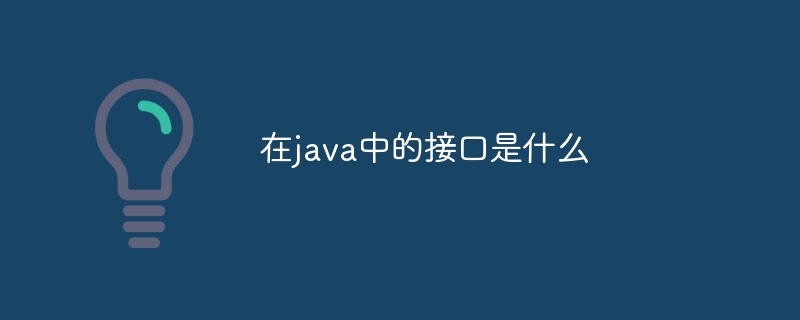
In Java, an interface is an abstract data type that allows the signature of a set of methods to be defined but does not provide implementation details. The interface plays the role of a bridge and contract between multiple classes in Java. , a class can implement one or more interfaces and meet the specifications of the interface by implementing the methods defined in the interface.

The operating system of this tutorial: Windows 10 system, Java19.0.1 version, Dell G3 computer.
In Java, an interface (Interface) is an abstract data type that defines the specifications of a set of methods but does not provide specific implementations of these methods.
Interfaces serve as bridges and contracts between multiple classes in Java. It defines a set of method signatures but no implementation details. A class can implement one or more interfaces and satisfy the specifications of the interface by implementing the methods defined in the interface.
The definition of the interface uses the keyword "interface" and can contain the following content:
Method signature: The methods in the interface only have the method name, parameter list and return type, but no method body. For example:
public interface MyInterface {
void method1();
int method2(String str);
}Constant: The interface can contain the definition of constants, which are public static final by default. For example:
public interface MyInterface {
int MAX_VALUE = 100;
String DEFAULT_NAME = "John";
}Default method: Starting from Java 8, interfaces can contain default methods. These methods have default implementations and can provide method bodies directly in the interface. For example:
public interface MyInterface {
void method1();
default void method2() {
System.out.println("This is a default method.");
}
}Static method: Starting from Java 8, interfaces can also contain static methods (static methods). These methods do not depend on specific instance objects and can be called directly through the interface name. For example:
public interface MyInterface {
void method1();
static void staticMethod() {
System.out.println("This is a static method.");
}
}The functions of interfaces have the following aspects:
Definition of contract: An interface can define a set of method specifications as a contract between multiple classes. Classes that implement this interface must provide concrete implementations of the methods defined in the interface.
Achieving polymorphism: Through interfaces, object polymorphism can be achieved. Even if the specific implementation class is not known, as long as the same interface is implemented, the method can be called through the interface type.
Decoupling: Interfaces can be used to decouple and reduce dependencies between classes. Through interface-oriented programming, the caller and the implementer can be decoupled, improving the maintainability and scalability of the code.
Multiple inheritance: Interfaces can implement multiple inheritance, and one class can implement multiple interfaces. This allows a class to have multiple behaviors without using multiple inheritance.
In summary, in Java, an interface is an abstract data type used to define the specifications of a set of methods. It provides multiple methods by defining method signatures, constants, default methods and static methods. Provides a contract and bridge between classes. Interfaces play an important role in object-oriented programming. They can achieve features such as polymorphism, decoupling, and multiple inheritance, and improve the maintainability and scalability of code.
The above is the detailed content of what is interface in java. For more information, please follow other related articles on the PHP Chinese website!
